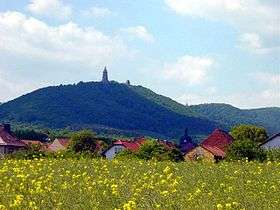Kyffhäuser
| Kyffhäuser | |
|---|---|
 The Kyffhäuser as seen from Tilleda, with the Kyffhäuser Monument | |
| Highest point | |
| Peak | Kulpenberg |
| Elevation | 1,553 ft (473 m) |
| Geography | |
| Country | Germany |
| States/Provinces | Thuringia and Saxony-Anhalt |
| Geology | |
| Orogeny | Variscan |
| Type of rock |
Sandstone, Conglomerate Carboniferous sedimentary, metamorphic rocks |
The Kyffhäuser (German pronunciation: [ˈkɪfˌhɔʏzɐ]), sometimes also referred to as Kyffhäusergebirge, is a range of hills located on the border of the German state of Thuringia with Saxony-Anhalt. It stands south of the Harz mountains. The range has a length of 19 kilometres (12 mi) and a width of 7 kilometres (4.3 mi). It reaches its highest point at the Kulpenberg (473.4 metres (1,553 ft)), situated in Thuringia. The Kyffhäuser has significance in German traditional mythology as the resting place of Emperor Frederick Barbarossa.
Geography
The Kyffhäuser is a Mittelgebirge located in the Kyffhäuserkreis district of Thuringia and the Mansfeld-Südharz district of Saxony-Anhalt, not far from the larger Harz range. The Kyffhäuser range is 19 km long (from west to east) and 7 km wide.[1]:124 The highest point is the Kulpenberg (473.4 metres (1,553 ft)), located in Thuringia. The range also borders on the Goldene Aue.
Some parts of the range in the west and south are karstified and bare of trees, covered by calcareous grassland.[1]:124
Etymology
The name Kyffhäuser probably stems from the word "cuffese" meaning head, dome or peak.
History
The settlement of Tilleda at the northern rim was already mentioned at the beginning of the 9th century in the Breviarium Lulli as Dullide, an estate of Hersfeld Abbey. A Kaiserpfalz at Tilleda is attested by the 972 marriage certificate of Emperor Otto II and Empress Theophanu.[2]:13–15
A first castle on the hill above the settlement may have been erected by Emperor Henry IV during his conflict with the Saxons. His son Henry V inherited the quarrels and the castle was finally slighted by the Saxon Duke (and later Emperor) Lothair of Supplinburg in 1119. Lothair himself started the reconstruction in his later years and the Imperial Castle of Kyffhausen (Reichsburg Kyffhausen) was completed under Emperor Frederick Barbarossa.
Kyffhäuser legend
Frederick Barbarossa drowned on 10 June 1190 in the Göksu River near Silifke during the Third Crusade. However, according to legend, Barbarossa is not in fact dead, but sleeps in a hidden chamber underneath the Kyffhäuser hills, sitting at a stone table. His beard has supposedly grown so long over the centuries that it grew through the table. As in the similar legend of King Arthur, Barbarossa supposedly awaits his country's hour of greatest need, when he will emerge once again from under the hill. The presence of ravens circling the Kyffhäuser summit is said to be a sign of Barbarossa's continuing presence.
Today
Today, the hills are a tourist site featuring a restored medieval castle from the 11th century, known as Reichsburg Kyffhausen.
Atop the mountain is the Kyffhäuser Monument, built in 1890–1896, which depicts German Emperor William I and Frederick Barbarossa. At the time of the monument's construction, William I was thought to have "laid to rest" Barbarossa by the 1871 unification of Germany. There is also a small museum and the castle well, at 176 m depth said to be "the deepest castle well in the world".[1]:126–127
See also
| Wikisource has the text of the 1911 Encyclopædia Britannica article Kyffhäuser. |
References
- Sven Frotscher: Der Kyffhäuser – Natur, Geschichte, Architektur, Denkmale Europas. Artern 1996, ISBN 3-00-000509-9
External links
Coordinates: 51°23′N 11°05′E / 51.383°N 11.083°E
